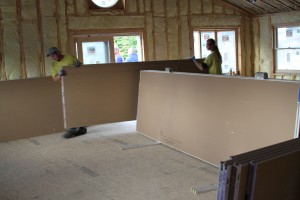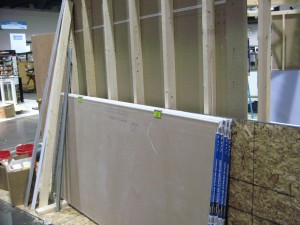DRYWALL SAFETY: STACKING DRYWALL By Myron Ferguson
It is interesting that when I was doing research on safety when stacking drywall on a job site I mostly found information on avoiding injuries while lifting and carrying drywall. There was also a lot of concerns about structural tolerances with all the weight. However in my research I did find an article in :Constructions Dimensions Magazine- July 2002, about the potential hazards of drywall stacked on edge and the potential for tipping and falling. In addition I also found a statement from the gypsum industry which states:that delivered drywall must be protected from moisture and placed on the jobsite in a flat orientation. This prompted me to contact my friends at RockSteady (the makers of a drywall safety clip) to get their take on the stacking drywall issue. They told me to be careful because it is a very complicated topic filled with potential liability. So I will preface this Blog by stating that the safety of people on the jobsite should take priority over any other concerns. Yes even over productivity!!
I hope it is already becoming clear that drywall stacked leaning against walls can be unsafe and is not recommended but if there is no other option here are some points to consider:
Verify distance with a measuring tape, ruler, or measurement template to ensure proper lean. Placing drywall sheets against a wall with a lean of less than four inches creates a serious tipping hazard. Placing sheets with greater than a 6” lean can cause significant lateral pressure and cause structural failure. Failure to do so may result in serious harm or injury. If sheets are stacked less than four inches from the wall it takes less than 30 lbs of lateral force to topple 24 sheets of drywall. Four to five inches only 50 lbs of force is needed. Workers should be aware that drywall sheets vary by thickness and weight: Some sheets weigh less than 55 pounds and others weigh more than 120 pounds. Lighter weight drywall is now available, but a 4 by 12 ft sheet of ½” drywall still weights about 60 lbs. Personally,I would not want someone to throw something that weighs 60 lbs at my legs. I am not just talking about the weight of a few pieces of drywall and maybe the sheet you are working with falling. Now I am talking about the potential of the entire stack of drywall toppling and the force of the falling drywall, which is much higher than just the weight of the drywall.
DO YOU WANT TO TAKE THE RISK?
As a residential drywall contractor I rarely see drywall stacked flat on a floor and like most contractors I prefer to have the drywall stacked on edge. One reason I like drywall stacked on edge against walls is because of the limited amount of space in a home under construction. Hanging drywall is a very productive phase of the construction. Stacking the drywall away from the areas being hung like in an attached garage for example would slow down production too much. Also end cutting, snapping, as well as ripping, and saw cutting the drywall panels must be done when the drywall is on edge.
But I have to admit that in many cases laying the drywall on the floor would work just fine when stacking, but it is not done because of old habits. A few sheets at a time could be stood on edge for measuring and cutting.
POTENTIAL PROBLEMS:
After work hours on many residential construction sites visitors such as the homeowners, other contractors stopping by to take measurements or drop off materials are at risk if they start climbing around or moving any drywall sheets. This is not to say that both invited and uninvited people can’t enter a commercial job site as well, but there is often more security in place on commercial sites.
Stacking flat on floors:
- Tendency to stack too high and overload the floor
- Harder to work with. Extra lifting and moving involved for each sheet.
- Takes up additional space and is more likely to be in the way especially if working on ceilings
- Finished face is walked on and edges of panels are often broken
Edge stacking against walls:
- Can create too much pressure against wall
- Dangerous, can easily tip over damaging the structure or worse landing on people
- A big concern is non- drywall contractors-employees working around the vertical stacks of drywall.
- More weight per sq ft on floor compared to flat stacking
- If stacked for a period of time drywall edges can become damaged by warping
BENEFITS:
Stacking flat on floors
- Will not have to worry about drywall falling over
- Drywall is flat which provides a flatter surface when hung. Flatter drywall makes flatter walls and ceilings.
- Weight is distributed more evenly per sq ft
Edge stacking against walls
- Easier for hangers to measure and cut
- Better use of limited space
- Small or narrow rooms can only accommodate edge stacked drywall especially if different lengths are being used
HELPFUL SAFETY TIPS:
- Don’t lean a different length against other drywall. A big concern for tipping is when a sheet is pulled out from behind the front stack.
- Don’t limit access to room by covering doorway.
- Keep the jobsite clean at all times
- Have control over who enters jobsite and when they can enter site
- A few sheets at a time can be stood on edge as needed so that cutting can be done from this position.
- Don’t have drywall delivered too much in advance of hanging.
- Avoid having other subs working in areas being drywalled
- Secure drywall for after work hours
- Emphasize safety over productivity
- Stack flat whenever possible
- Make sure the delivery personnel understand how and where you want materials stacked
- Rocksteady clips securing a stack of drywall ( photo below)
SECURE – WARN – PROTECT
The RockSteady® Clip prevents accidents by protecting jobsite visitors and contractors from the potential harm of falling drywall. It does this by securing sheets of drywall, leaned against a wall, into a stabilized stack. After installation, the clip offers round the clock protection for workers and visitors from the hazard of incidental or accidental stack tip-over.CONCLUSION:
All in all stacking drywall should be taken much more seriously. Stacking drywall flat is the most effective way to prevent injuries from toppling drywall. Personally I will be very careful when stacking drywall leaning against a wall and will use all the precautions outlined above.


What is the law/rules about the number of sheets against a house stud internal wall? Is it like 15-20 or an exact amount?
As mentioned in the blog leaning drywall against walls is dangerous so try and follow recommendations I outlined.
Besides the danger of the drywall tipping over there is the concern of weight both against the wall and on the floor. I have not been able to find a limit but I think 15 to 20 sheets is the limit. I would contact RockSteady for more information.
Is there no actual osha standard to this?
Couldn’t find anything. Lots of good information on the rocksteadyclip site. Mostly what I could find in OSHA was about not stacking in unsafe locations or blocking off access paths. It is obvious that stacking flat on the floor is safest but is rarely done in residential construction. I like to be on site when the drywall is delivered to make sure stacks are located in safest locations.
We make a product that doesn’t require tools, is 100% reusable over and over and is so reliable that it will actually hold the weight of drywall as long as the wall will. Ours also fits on 5/8″ and 1/2″ sheets as well. Check out our website
http://Www.quickclipdrywall.com